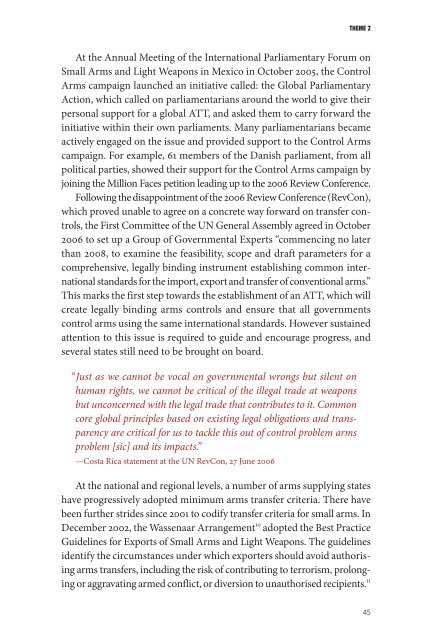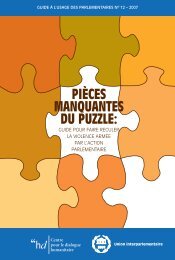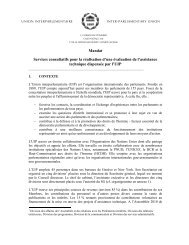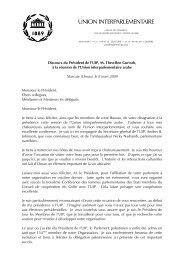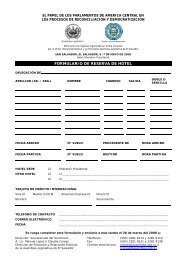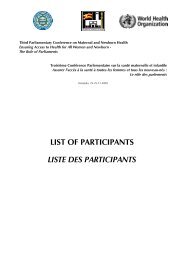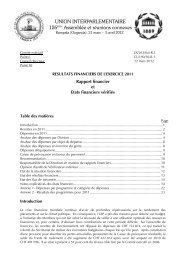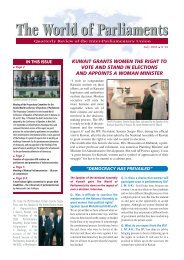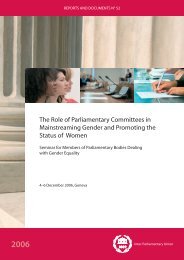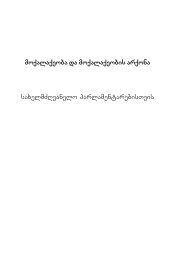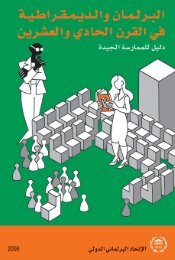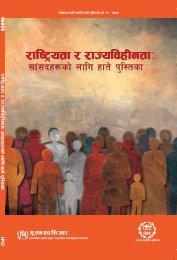MISSING PIECES - Inter-Parliamentary Union
MISSING PIECES - Inter-Parliamentary Union
MISSING PIECES - Inter-Parliamentary Union
Create successful ePaper yourself
Turn your PDF publications into a flip-book with our unique Google optimized e-Paper software.
THEME 2<br />
At the Annual Meeting of the <strong>Inter</strong>national <strong>Parliamentary</strong> Forum on<br />
Small Arms and Light Weapons in Mexico in October 2005, the Control<br />
Arms campaign launched an initiative called: the Global <strong>Parliamentary</strong><br />
Action, which called on parliamentarians around the world to give their<br />
personal support for a global ATT, and asked them to carry forward the<br />
initiative within their own parliaments. Many parliamentarians became<br />
actively engaged on the issue and provided support to the Control Arms<br />
campaign. For example, 61 members of the Danish parliament, from all<br />
political parties, showed their support for the Control Arms campaign by<br />
joining the Million Faces petition leading up to the 2006 Review Conference.<br />
Following the disappointment of the 2006 Review Conference (RevCon),<br />
which proved unable to agree on a concrete way forward on transfer controls,<br />
the First Committee of the UN General Assembly agreed in October<br />
2006 to set up a Group of Governmental Experts “commencing no later<br />
than 2008, to examine the feasibility, scope and draft parameters for a<br />
comprehensive, legally binding instrument establishing common international<br />
standards for the import, export and transfer of conventional arms.”<br />
This marks the first step towards the establishment of an ATT, which will<br />
create legally binding arms controls and ensure that all governments<br />
control arms using the same international standards. However sustained<br />
attention to this issue is required to guide and encourage progress, and<br />
several states still need to be brought on board.<br />
“Just as we cannot be vocal on governmental wrongs but silent on<br />
human rights, we cannot be critical of the illegal trade at weapons<br />
but unconcerned with the legal trade that contributes to it. Common<br />
core global principles based on existing legal obligations and transparency<br />
are critical for us to tackle this out of control problem arms<br />
problem [sic] and its impacts.”<br />
—Costa Rica statement at the UN RevCon, 27 June 2006<br />
At the national and regional levels, a number of arms supplying states<br />
have progressively adopted minimum arms transfer criteria. There have<br />
been further strides since 2001 to codify transfer criteria for small arms. In<br />
December 2002, the Wassenaar Arrangement 10 adopted the Best Practice<br />
Guidelines for Exports of Small Arms and Light Weapons. The guidelines<br />
identify the circumstances under which exporters should avoid authorising<br />
arms transfers, including the risk of contributing to terrorism, prolonging<br />
or aggravating armed conflict, or diversion to unauthorised recipients. 11<br />
45


